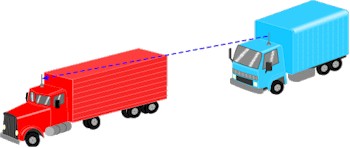|
Mainland High School
Suitable for a Disaster: ISTF 08-1835 |
||||||
|
Home
Introduction Contest Components One Two  Product Product
Three Fabrics History of Fabrics Smart Fabric Projects Sensors Nano Sensors Power Production Communication Cell Phones 3G Phones Data Transfer Helikites Interoperability Microwaves Relief Agencies Telecommunication Project Assessment Team |
Cell Phone Operations
A long time ago, before cell phones, there were
mobile radio telephones that were used in cars if you absolutely needed some
type of mobile communication. Two problems arise with radio telephones; there is
only one really large central antennae in the city, with only 25 channels. This
translates to only 25 people communicating at once on a radio telephone system.
To broadcast 40-50 miles, a very large transmitting antennae must be installed on
the user's car which poses the second problem.
A good way to show how superior cell phones are to radio telephones, walkie-talkies, and CB radios, is comparing their duplexes. Cell phones use "full duplex" meaning that the device uses one frequency to talk and one frequency to listen. CB radios and walkie-talkies use "half duplex." This uses one duplex for both listening and talking. Because there is only one frequency, only one person can talk at one time, while the other person must listen.
Cell phones are also superior to CB radios and walkie-talkies in range and number of channels. Motorola Talkabout T6320 and Audiovox GMRCPS are two modernized walkie-talkies that have a range of about 2 miles, usually 14 channels, and numerous modern-day features: digital compass, altimeter, thermometer, NOAA weather broadcasts, and a GPS. CB radios have 40 channels and since they are much more powerful than walkie-talkies, can generally transmit up to 5 miles. Cell phones typically have 1664 channels to communicate on and a range of hundreds of miles due to the use of cell towers. Cell towers usually transmit within a 10 mile radius and are generally thought of as hexagons in a huge hexagonal grid. Each cell phone carrier receives up to 800 frequencies in any given city. The reason that a car can travel hundreds of miles and "remain connected" is because the transition between "cells" is seamless as the signal carries over. Shockwave animation courtesy of How Stuff Works There are three principal generations of cell phones. 1G is the oldest, and the least efficient. On a 1G or normal analog network, there are only 56 voice channels per cell. With the 2G network there are triple the voice channels because of digital transmission. It's very important to know that both the cell phone and the base stations at the cell towers transmit at low wattage. The importance of this is that the signal transmitted does not make it very far out of the cell, allowing frequencies to be reused from cell to cell. A 3G network has a wider service area as well as a wider range of services, including voice data, video data, and broadband wireless data. A cell tower network requires numerous base stations per city. There can be hundreds of towers in large cities. Because there are so many base stations and towers, there is a central office called Mobile Telephone Switching Office (MTSO) for each provider or carrier. Every cell phone contains special codes that are used to identify that particular cell phone. There are 3 types of cell phone codes: Electronic Serial Number (ESN), Mobile Identification Number (MIN), and System Identification Code (SID). The SID is a 5 digit code unique to your network provider. Shockwave animation and caption courtesy of How Stuff Works When you initially turn on your cell phone, the cell that you are in looks for your SID. The sole purpose of the control center is to help the base station and cell phone communicate back and forth. If the cell phone cannot find a control channel to listen to, than it knows it's out of range. If it connects to a control channel and the SID is confirmed, then the phone knows it is in one of it's "home systems." Your phone then sends a registration request to the MTSO. When your phone registers, MTSO logs which cell your phone was in and puts it into the database, so that it knows what cell to ring you in. The MTSO also keeps track of the last cell you were in so it knows where to look first. When you call someone, the MTSO picks the two frequencies that your phone will be working with. After all this process, you're connected with your friend on what is basically two-way radio. The reason you're able to go from cell to cell is because of the technology in the base station of the towers. These base stations can tell that your signal is diminishing and so it "hands off" your signal to another tower. Say you go into another city, or into another branch of your city that uses a different MTSO, the MTSO you're currently in recognizes that you're not in the right place and then goes back to your home MTSO to make sure your SID is valid. Forbes - Walkie-Talkies For Grownups http://www.forbes.com/2001/03/02/0302tentech.html FunSMS - Mobile Phone Generations http://www.funsms.net/mobile_phone_generations.htm How Stuff Works - Cell Phone Codes http://electronics.howstuffworks.com/cell-phone3.htm How Stuff Works - Cell Phone Frequencies http://electronics.howstuffworks.com/cell-phone1.htm Phone Warehouse - Mobile Phone History http://affordablephones.net/HistoryMobile.htm |
|||||

